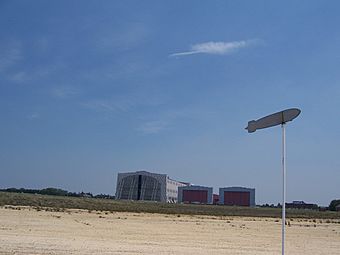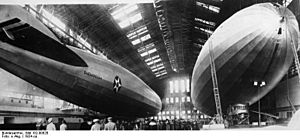Lakehurst Hangar No. 1 facts for kids
|
Hangar No. 1, Lakehurst Naval Air Station
|
|

The Hindenburg Disaster Marker
|
|
| Location | JB MDL Lakehurst, Manchester Township, New Jersey |
|---|---|
| Area | 211,434 square feet (19,640 m2) |
| Built | 1921 |
| NRHP reference No. | 68000031 |
Quick facts for kids Significant dates |
|
| Added to NRHP | May 23, 1968 |
| Designated NHLD | May 23, 1968 |
Hangar No. 1 is a giant building for airships located at Naval Air Engineering Station Lakehurst in Manchester Township, New Jersey, United States. It was the place where the famous German airship, the Hindenburg, was supposed to land on May 6, 1937. Sadly, the Hindenburg caught fire while landing, in what became known as the Hindenburg disaster.
Built in 1921, Hangar No. 1 is one of the oldest buildings still standing from the early days of lighter-than-air flight. This means it's a very important historical site for understanding how people learned to fly huge airships. Because of its history, it was named a National Historic Landmark in 1968.
Contents
What is Hangar No. 1?
In 1921, the United States Navy started the Lakehurst Naval Air Station. This base was created to be the main center for "lighter-than-air" flight. This type of flight uses aircraft that are lighter than the air around them, like airships and blimps. The Navy wanted to experiment with and develop large, rigid airships for both military and travel uses.
Hangar No. 1 was the very first big building constructed at Lakehurst. Its purpose was to hold these massive helium-filled airships.
How Big is the Hangar?
The Lord Construction Company finished building the hangar in 1921. It's an incredibly large building! It is 966 feet (294 m) long, 350 feet (110 m) wide, and 224 feet (68 m) high. That's like having a building as long as three football fields! The total floor space is 211,434 square feet (1.964 ha).
The hangar has huge steel doors at each end. These doors are so big that they are separate from the main hangar structure. Each door weighs 1,350 tons – that's heavier than 1,350 small cars! Two 20-horsepower motors power each door to open and close them. However, they could also be opened by hand, which needed nine strong people working together.
Inside the hangar, there are also railroad tracks. These tracks led out to the areas where airships would be tied down outside the hangar. The hangar was so large that it could hold two big rigid airships at the same time, plus other smaller blimps.
Famous Airships and Uses
Hangar No. 1 has been home to many famous airships throughout history.
Building the USS Shenandoah
From 1922 to 1923, the hangar was used to build the USS Shenandoah (ZR-1). This was the first rigid airship built by the United States Navy. On September 4, 1923, the Shenandoah took its first short flight near Lakehurst.
Home to Other Giants
In 1924, the US Navy received another rigid airship from Germany. This airship, the USS Los Angeles (ZR-3), was given to the United States as a payment after World War I. The Los Angeles shared Hangar No. 1 with the USS Shenandoah.
The hangar also provided a place for other well-known airships, including:
- The German Graf Zeppelin (LZ 127)
- The USS Macon (ZRS-5)
- The USS Akron (ZRS-4)
- The German LZ 129 Hindenburg during its flights across the Atlantic Ocean.
Modern Uses of the Hangar
Today, Hangar No. 1 is still very active! It holds a practice aircraft carrier flight deck. This is used to train people who work on real aircraft carriers.
Since 1926, a club called the East Coast Indoor Modelers has been allowed to use the hangar. They fly indoor free flight model aircraft here. These are self-powered model planes that fly best in large, wind-free spaces like the hangar.
Since 1994, the Ocean County Vocational Technical School has run its Career & Technical Institute inside the hangar. This institute offers programs for adults in aviation and electronic technologies.
Besides Hangar No. 1, there are five other airship hangars at Lakehurst. These are now used for training, testing, and storage.
Images for kids







